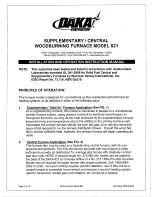
RECOMMENDED FUELS
Please note
If you live in a UK Smoke Control Area
you must only burn approved smokeless fuels. The
following fuels are approved by Graphite for use in
the GR910-B Graphite Boiler stove:
•
Wood Logs
Only ever use dried, fully seasoned
chopped wood logs with a moisture content of less
than 20%.
Wood which is well seasoned makes a distinctive
‘clack’ rather than a dull ‘thud’ when knocked
together. It will also feel much lighter than an
unseasoned log. Other indicators include bark peeling
away and cracking and splitting around the outside.
Ideally wood should be seasoned outdoors for
between 18 to 24 months – the harder the wood
then the longer the seasoning. It should be stacked
off the ground with plenty of space between the logs
to allow air movement and with the top covered to
keep rain and snow out. It is said that seasoned wood
will provide approximately 50% more heat output
than the equivalent unseasoned log.
Most types of hardwood, for instance Ash (generally
regarded as the best), Birch, Beech, Oak and Elm can
be used. However, avoid woods with a high resin
content. As a rule of thumb, the heavier the wood,
then the greater the heat output and the longer burn
time – the time between refills. All of this is providing
that it is fully seasoned wood.
Never use wet or unseasoned (green) wood as this will
cause nuisance smoke and a very disappointing fire.
Its use could quickly result in the build up of soot and
creosote – in a matter of weeks sometimes, which
because of the higher temperatures of stove flue
gases, could easily cause a flue or chimney fire. In
addition, burning wet wood creates other
environmental problems, a less efficient fuel economy
and can eventually clog your flue system and cowl. It
will also reduce the effectiveness of the stove’s
Airwash system thus causing staining and blackening
of the glass.
Wet or unseasoned would produces the following
poor performance:
• Hard to light fires
• Fires that are difficult to keep going or to keep
burning well
• Smoky fires with fewer flames which are also of a
dull orange colour
• Increased dense grey / blue smoke from the chimney
• Shorter burn times
• Low heat output
• Dirty glass and firebricks
• Excessive and rapid creosote build-up in the flue
system and chimney
• Unpleasant smoky smells both inside and sometimes
outside the house
In the event of a problem with your stove – always
check your choice of fuel first!
Manufactured or finished wood products, such as
plywood and chipboard, must also be strictly avoided
because of the high chemical adhesive content used
in their production which will also leave harmful,
potentially corrosive, residue inside the stove and flue
system.
For more information about wood fuel visit the
DEFRA funded National Energy Foundation website
Logpile
at
www.nef.org.uk/logpile.
• Peat or ‘Turf’
Peat is an excellent cost-effective fuel
alternative and provides a similar calorific heat output
to wood. It’s also clean and easy to handle with low
atmospheric emissions. However, you must ensure
that the peat is kept thoroughly dry as it absorbs and
retains unwanted moisture very easily.
Peat has traditionally been used as a heating fuel in
both Scotland and Ireland and you can find out more
by visiting these suppliers’ useful websites – www.
peatheat.co.uk (Scotland) and www.bnm.ie/fuels
(Ireland).
Should you prefer to burn peat we would strongly
recommend using 904L grade flexible liner to line your
chimney as this is more resistant to the acids in peat.
• Multi Fuels (Other than Wood or Peat)
If you
cannot burn wood then we recommend burning a
smokeless alternative, such as smokeless ovals, as this
is better for the stove and flue system as well as the
environment. Your stove is also approved to burn coal
– however, we do not recommend prolonged use of
bituminous house coal because of the excessive soot
it produces. There are many different brands of high
quality smokeless coal ovals available in the UK and
Ireland. The most popular include Phurnacite, Taybrite,
Ancit and Homefire.
Your local fuel merchant will be able to advise you on
the best types of coals suitable for multi fuel stoves,
as well as natural mineral fuel alternatives such as
anthracites which burn cleanly. The following fuel
merchant’s website also has good descriptions of the
comparative benefits that the brands listed above
have to offer –
www.coalproducts.co.uk
.
You can also find out more by visiting the Hetas
website
www.hetas.co.uk
.
PROHIBITED FUELS
Never use your stove like an incinerator. Burning
prohibited ‘fuels’ in a Smoke Control Area is illegal.
Burning the following materials could also damage
your stove and flue system, rendering the product
warranties on the stove and flue system components
void.
13
Содержание GR910-B
Страница 4: ...4 GENERAL DIMENSIONS ...
Страница 22: ... 23 ...













































